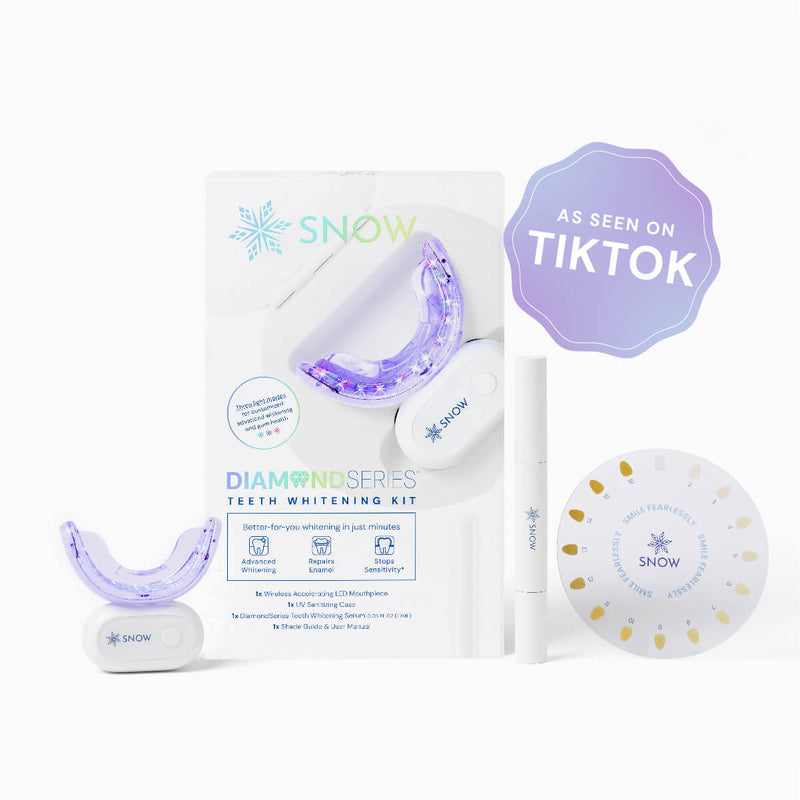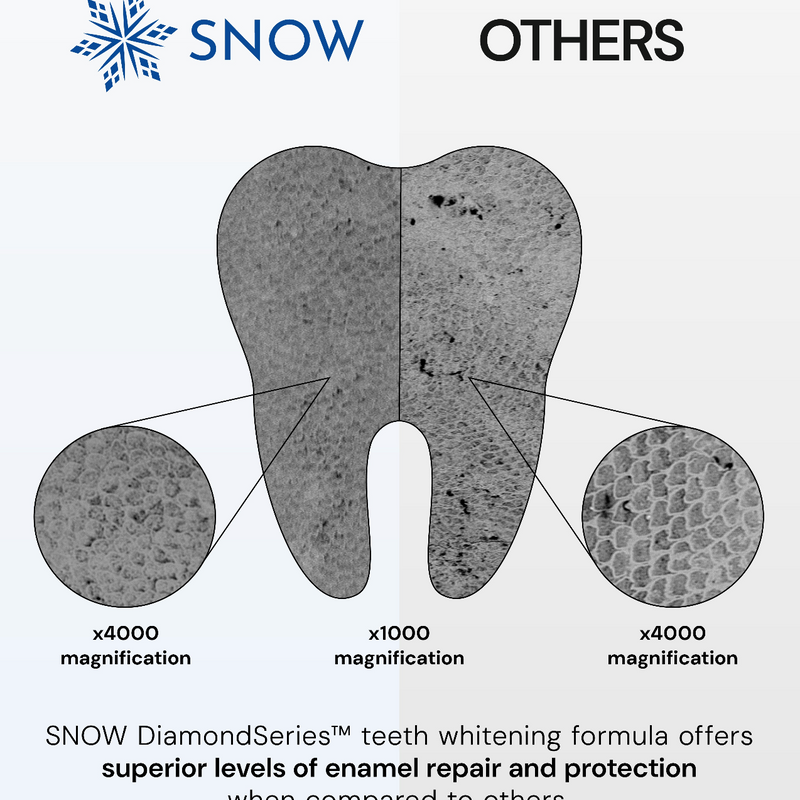When it comes to knowing when to change toothbrush after strep, the recommended action is to replace your toothbrush promptly after recovering from strep throat. This prevents the risk of reinfection and maintains proper oral hygiene.
Changing toothbrushes is a simple yet crucial step in this process, ensuring that all remnants of bacteria are eliminated from your oral care tools.
Ensuring optimal oral hygiene is crucial, especially after dealing with illnesses like strep throat. At SNOW, we understand the significance of maintaining clean toothbrushes for overall dental health.
In this article, we'll delve into various questions related to toothbrush replacement after strep throat, including the lifespan of a toothbrush, methods for sanitization, and the potential risks of not replacing your toothbrush.
By providing expert insights and tips, we aim to empower you to make informed decisions regarding your oral care routine.
What this article covers:- Do Germs Stay on Your Toothbrush?
- Do You Need to Replace Your Toothbrush After Strep Throat?
- Why Does Strep Recur?
- What Happens If You Don't Change Your Toothbrush After Being Sick?
- How to Sanitize Your Toothbrush
- Changing Toothbrush FAQs
Do Germs Stay on Your Toothbrush?
Yes, toothbrushes can indeed harbor germs, including bacteria and viruses.
According to a study published by the National Center for Biotechnology Information, these microorganisms can transfer onto the bristles when you brush your teeth.
If left unchecked, they can persist on the toothbrush surface, potentially leading to oral health issues. Proper storage and regular cleaning are essential to minimize germ buildup and maintain hygiene.

Can Your Toothbrush Make Others Sick?
Certainly, it can. If your toothbrush harbors pathogens, it poses a risk of transmitting illnesses to others.
Whether through direct use or contamination of shared spaces, a contaminated toothbrush can spread infections.
Practicing good hygiene, such as proper toothbrush storage and regular replacement, is crucial to mitigate this risk.
By maintaining clean toothbrushes, we can contribute to overall oral health and prevent the spread of diseases.
Do You Need to Replace Your Toothbrush After Strep Throat?
Yes, it's crucial to replace your toothbrush after recovering from strep throat to prevent the risk of reinfection or spreading the bacteria.
Strep throat is highly contagious, and your toothbrush can harbor the bacteria even after you've gotten better. Ensuring proper hygiene practices is essential for maintaining oral health, especially after an illness.
At SNOW, we offer advanced whitening electric toothbrushes that prioritize both cleanliness and effectiveness. Our LED Teeth Whitening Electric Toothbrush and Advanced Whitening Electric Toothbrush are designed to provide thorough cleaning while promoting whitening effects.
Some users report that an electric toothbrush feels weird at first, but this sensation typically diminishes as you become accustomed to the new cleaning method.
Additionally, we offer replacement brush heads for our advanced LED electric toothbrush, ensuring convenience and hygiene after being sick with strep throat.
By investing in our electric toothbrushes and replacement heads, you can maintain optimal oral hygiene and reduce the risk of bacterial transmission, even after recovering from strep throat.

Why Does Strep Recur?
Understanding the factors contributing to recurrent strep throat infections is crucial for effective prevention and management.
Strep throat can be a persistent issue for some individuals, leading to frustration and discomfort. SNOW explores the reasons behind the recurrence of strep throat to provide insights into maintaining optimal oral health and hygiene.
Resistance To Antibiotics
According to VeryWellHealth, strep throat bacteria can adapt and become resistant to antibiotics over time, complicating treatment efforts and increasing the likelihood of recurring infections.
Weak Immune System
Individuals with a weakened immune system are more prone to recurrent strep throat infections.
Strengthening overall health and hygiene practices is essential for bolstering immune function and reducing susceptibility to infections.
Hidden Carrier
Some people can carry strep bacteria in their throat without showing symptoms, acting as a reservoir for recurrent infections.
Proper management of hidden carriers is necessary to prevent the spread of strep throat.
Dental Health
Poor oral hygiene and untreated dental issues can increase the risk of recurrent strep throat.
Regular dental check-ups, along with proper oral care, play a crucial role in preventing complications and reducing the recurrence of strep throat.
It's also wise to monitor for any unusual signs, such as your toothbrush turning pink, which could indicate bacterial growth or contamination.
What Happens If You Don't Change Your Toothbrush After Being Sick?
Neglecting to replace your toothbrush after an illness can have adverse effects on your oral health.
Here's what may occur:
- Pathogen reintroduction: Continued use of a contaminated toothbrush reintroduces pathogens into your mouth, increasing the risk of reinfection or prolonged illness.
- Bacterial buildup: Bacteria from your previous illness linger on the bristles, contributing to bacterial buildup and potentially causing oral health issues.
- Cross-contamination: If multiple people share the same toothbrush holder or space, there's a risk of cross-contamination, spreading germs and illnesses.
- Reduced effectiveness: An old, worn-out toothbrush is less effective at removing plaque and bacteria, compromising your oral hygiene routine.
To maintain optimal dental health, it's crucial to replace your toothbrush after recovering from an illness and adhere to regular replacement intervals.
How to Sanitize Your Toothbrush
Ensuring your toothbrush stays clean is essential for maintaining oral hygiene. Here are effective methods to sanitize your toothbrush:
- Soak in mouthwash: Submerge your toothbrush in mouthwash for a few minutes to kill bacteria and freshen the bristles.
- Hydrogen peroxide solution: Create a mixture of hydrogen peroxide and water and soak your toothbrush in it to disinfect effectively.
- Vinegar solution: Soaking your toothbrush in a vinegar solution can help eliminate bacteria. Rinse thoroughly afterward.
- Boiling: Boil your toothbrush in water for a few minutes to kill germs. Ensure it cools down before use.
- UV sanitizers: UV sanitizers can effectively kill bacteria on your toothbrush. Follow the manufacturer's instructions for proper usage.
Remember, while these methods can reduce bacterial contamination, regular toothbrush replacement is still necessary for optimal oral hygiene.
Changing Toothbrush FAQs
Should I disinfect my toothbrush after I've been sick?
Disinfecting your toothbrush after an illness can help reduce the risk of contamination. Simple methods like soaking the brush in antibacterial mouthwash or hydrogen peroxide solution can help kill germs. However, replacing the toothbrush is still recommended for optimal hygiene.
Can you sanitize a toothbrush after being sick?
Yes, you can effectively sanitize a toothbrush after being sick using multiple methods available at home.
These include boiling water, mouthwash, or UV sanitizers. Boiling water can kill most bacteria and viruses.
How often should you change your toothbrush?
For maintaining excellent oral hygiene, it's advisable to change your toothbrush every three to four months. This timeframe aligns with the recommendations of dental professionals, ensuring that your toothbrush remains effective in plaque removal and prevents the accumulation of bacteria on its surface.
Additionally, if you notice the bristles of your toothbrush becoming frayed or worn before the three-month mark, it's a sign that it's time for a replacement.
Conclusion
Regularly changing your toothbrush, especially after being sick with strep, is crucial for maintaining oral hygiene.
The article highlights the importance of replacing toothbrushes to prevent reinfection and maintain optimal dental health.
By swapping out your toothbrush promptly, you minimize the risk of harboring bacteria that could lead to further illness. It's essential to prioritize your health by adopting this simple yet effective practice.
Additionally, consider incorporating teeth whitening into your dental care routine for a brighter, healthier smile. SNOW offers premium toothbrushes and whitening solutions to enhance your oral hygiene regimen.
Elevate your dental care routine with SNOW's innovative products and achieve a radiant smile. Visit SNOW's website today to explore their range of teeth whitening options.
If you want to learn more, why not check out these related posts:
- Toothbrush Hurt My Gums
- Why Should You Change Your Toothbrush Every 3 Months
- Best Electric Toothbrush for Small Mouths
- Bamboo Toothbrush Benefits
- Tongue Scraper vs. Toothbrush
- Soft vs. Extra Soft Toothbrush
- Electric Toothbrush Round Head vs Oblong
- Bamboo Toothbrush Mold
- How to Clean Toothbrush
- When to Change Toothbrush After Being Sick
- How to Clean Electric Toothbrush
- Does Electric Toothbrush Clean Better?
- Can Your Toothbrush Make You Sick?
- Cleaning Toothbrush with Vinegar
- Toothbrushes for Braces
























